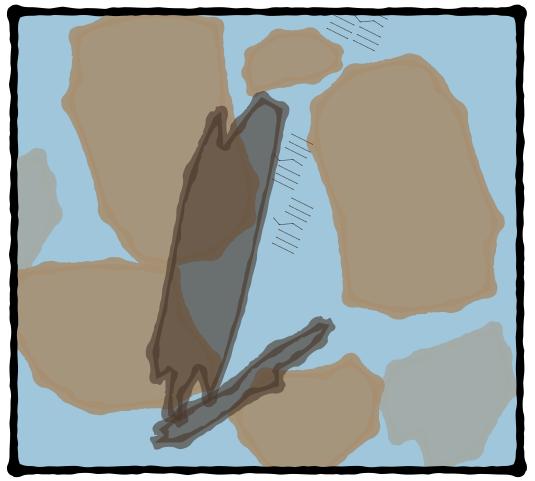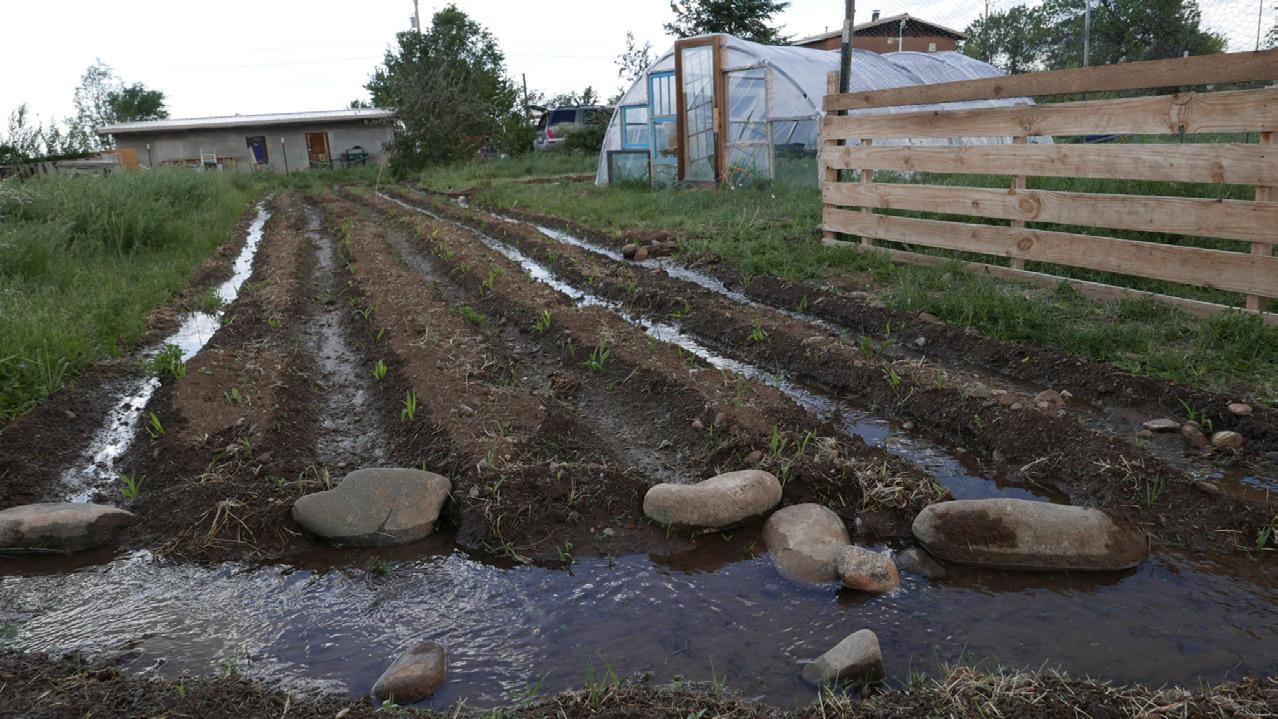
7 minute read
Activity - Water Infiltration
is no longer under water and is just glistening.
9. Record the Number of minutes
Advertisement
10. Repeat infiltration test in the same ring, with a second 15 oz (444 mL) of water.
11. Record the Number of minutes elapsed for the second infiltration measurement
Calculations
1. Calculate the fraction of an hour it took for 1 inch of water to infiltrate into damp soil:
2. Calculate the infiltration rate: Note: If soil moisture is at or near field capacity, you can end the test after step 8. The moisture content of the soil will affect the rate of infiltration; therefore, two infiltration tests (see step 9 and 10) are usually performed if soil is dry. The first inch of water wets the soil, and the second inch gives the estimate of the infiltration rate of the soil.
__________ min ÷ 60 = __________
1 inch ÷
1 inch ÷
Fraction of an hour Infiltration rate
________ in/hr
Interpretation
Using the chart, how would you interpret the infiltration rate of your soil? What physical characteristics do you think are responsible for the infiltration rate you determined? Number of minutes ÷ 60 = Fraction of an hour
Infiltration rate (inches/hour)
> 6
0.2 to 6
Infiltration class
Rapid
Moderate
0.0015 to 0.2 Slow
less than 0.0015 Impermeable
How does water move through soil?
Water enters and flows through a soil’s pore space. Macropores are large enough for plant roots to penetrate, and therefore the water in them is available to plants. Plants suck water from soil space through their roots and into their stems and leaves, and the water then returns to the atmosphere as water vapor. Water in macropores is also susceptible to leaching through the downward force of gravity. As a soil dries, water is held tightly in micropores, where it is not available to plants because even fine root hairs are too large to penetrate tiny micropores.
We can follow the changing conditions in soils as they lose water. It is especially important to note that plants are like Goldilocks in the story of the three bears—too much water in the soil is not suitable for them; too little is not suitable for them; but the middle amount is just right.
Glossary
Saturation
occurs when all of a soil’s pore space is filled with water; a saturated soil contains no air.
Glossary
Field Capacity
full saturation of the soil, minus water lost to free drainage by gravity.
Glossary
Permanent Wilting Point
the condition in which there is still water in the soil but it is held so tightly to soil physical components (especially small particles like clay) that plants are not able to extract it fast enough to meet their needs.

Saturation
We start with a saturated soil, for example after a heavy rain or an irrigation event.
At saturation, root function is limited because there is no oxygen available in the soil to help power their cellular activities (for more on this see “Biological characteristics,” page 51).
Note: The soil structure is weakest at the point of saturation, and so this is not a good time to run machinery over it.
Field Capacity
As time goes on, water drains due to gravity and soil reaches field capacity.
At field capacity, the soil’s largest pore spaces will be filled with air.
Sandy soils reach field capacity about two days after a major rainfall or irrigation event, but soils with more clay take much longer to reach field capacity.

Permanent Wilting Point
As the soil continues to dry due to evaporation and drainage, it will reach the permanent wilting point.
In conditions of true permanent wilting point, a plant will not recover.
Water holding capacity
Glossary
Water Holding Capacity
the amount of water that is in the soil between field capacity and the permanent wilting point.
The amount of water that is available to plants is also related to water holding capacity, which in turn is related to soil texture.
The same processes of draining and drying out occur in all soil types but can take different amounts of time. Think of a water droplet moving from the top to the bottom of each panel in the pore space figure (page 30) and how much longer and more tortuous one soil would be compared to the other. Different soils hold different amounts of water and therefore have different water holding capacities.
Texture class (see “Soil Texture Class”, page 21) Water holding capacity (inches of water per foot depth) Soil water behavior
Coarse sand
Loamy Sand
Silt Loam
Silty Clay
Clay 0.25 to 0.75
1.1 to 1.2
2 to 2.5
1.5 to 1.7
1.2 to 1.5 Drains very quickly
Drains moderately quickly
MOST available to plants
Held moderately tightly
Held very tightly
Note: For a given soil texture class, compaction and salt accumulation will further reduce water holding capacity.
Organic matter can directly and indirectly increase water holding capacity. Organic matter holds more water than a similar volume of mineral soil, but can hold it more tightly (like clay). Organic matter also improves soil structure, which in turn can affect water holding capacity by increasing the size of pore spaces.
2.2 Chemical Characteristics
Chemical characteristics include the ways that different compounds in the soil react with each other and cycle in and out of the system. For example, you will learn that pH can affect how easily a plant can access some kinds of nutrients and thus be either wellfertilized or deficient. Different conditions can lead either to compounds dissolving in water and washing away or to their accumulating as solids in the soil, for example as a salt crust.
Chemical characteristics are tightly related to the activity of living organisms. The building blocks of life are primarily the elements carbon, nitrogen, oxygen, hydrogen, sulfur and phosphorus. In cells, these compounds form molecules of proteins (structure and metabolism), carbohydrates (structure and energy), fats (energy and signaling), and nucleic acids (genetic information). When combined to form living organisms, chemicals become biological. Microbial activity is essential for breaking down and processing raw or decomposing materials into forms usable by other life forms, which we will discuss further in the biological characteristics section (page 51). Understanding the availability of the different chemical elements and compounds in soil is essential to understanding soil productivity.
Learning Outcomes
After completing this section you will be able to:
• Describe where soil pH comes from and how it affects soils in New Mexico and Colorado
• Describe the nutrients essential for a productive soil
• Discuss how soil pH interacts with nutrient availability
• Understand the C:N (carbon to nitrogen) ratio and what it means for soil productivity
• Describe where salts in soils come from and the difference between salinity and sodicity
Water
How does water enter soil?
Water influences every aspect of soil— physical, chemical, and biological—because of its unique chemical properties. From the initial stage of soil formation to transporting soil nutrients after a rain event to providing the habitat for soil microbial communities and water for plant growth, water is essential to understanding soils and soil health. Water behaves in a unique way when interacting with soil aggregates, which gives soil water some special properties that are important to consider when managing a ranch or farm.
One major property of water is that a lot of compounds dissolve in it and so can be transported through soil. For example, dry inorganic fertilizer is not accessible to the roots of plants until it dissolves in water and moves down to the soil’s rooting zone.
Additionally most of the microscopic life in soils is active in water films that form on soil aggregates. All processing of organic matter and other soil minerals and nutrients depends on the presence of water. In semiarid New Mexico and Colorado, where rainfall is seasonal and dry spells are intense, these processes are also seasonal (for more on this, see the chapter on biological characteristics, page 51).
The source of irrigation water and how it gets to a property can determine what minerals come with it. If it flows in open dirt ditches, it will pick up minerals on its way to your property, and these could be concentrated by evaporation. Groundwater, on the other hand, can pick up minerals from the bedrock surrounding it and can be quite rich in sodium, calcium, iron, or sulfur. When these mineral-rich waters are used to irrigate crops or pasture, there may be impacts on soil structure and plant health. This is why it is important to evaluate irrigation waters as part of soil testing (which will be covered in the section on monitoring and evaluation, page 80).











